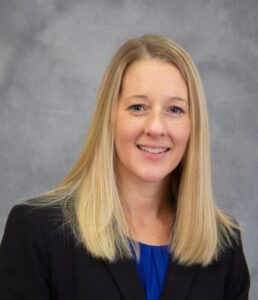The COVID-19 pandemic has shown the critical need for nurses across the nation. According to reports in 2020, half of states in the country faced shortages of nurses during the pandemic, including Minnesota. In the next decade, more than one million nurses will retire, while the aging population while put even greater demands on health care staffing.
A new high-fidelity patient simulator in Gustavus Adolphus College Department of Nursing will help address this pressing need for nurses. Simulators are computerized manikins that can be programmed to exhibit realistic medical symptoms and respond to care. For example, if students perform CPR on a manikin, it will respond in real time to the actions. Manikins can even “die” in a realistic manner.
The Gustavus nursing department expanded its simulation lab with the addition of an obstetric manikin. This patient simulator resembles a pregnant woman who shows vital signs, simulates emergency conditions, and gives birth. Students can even check fetal heart sounds on the manikin.

Associate professor of nursing Jessica Stadick explained that patient simulators allow students to practice critical care skill in real time. “High-fidelity simulation allows students to practice in a safe and controlled environment” she said. “If the students make mistakes, then they can learn from them in real time and re-apply the correct actions without compromising patient safety.”
Expansion of the simulation lab is especially important for Gustavus due to its setting in a smaller community. Clinical experience is essential for nursing students, but opportunities for that kind of training are limited in rural areas. “Competition for clinical sites is increasing across the state. Our students have to travel for their clinical experience,” Stadick said. “With the addition of this high-fidelity manikin, students will be able to learn obstetric and critical care skills on campus.”
Many Gustavus nursing students come from smaller towns and plan to work in health care in rural areas. The simulation patients give them the broad training they will need to practice in these settings. “Numerous alumni are working in critical-access rural hospitals across Minnesota and in other states,” Stadick said. “They must be competent in all areas of nursing, as nurses in these hospitals typically work on the surgical floor, in labor and delivery, and in the emergency department.”
Purchase of the patient simulator was made possible by a $111,791 grant from the Otto Bremer Trust. Based in St. Paul, the Otto Bremer Trust is a bank holding company and a private charitable trust that works at the intersection of finance and philanthropy. Created in 1944 by Otto Bremer, it is today one of the nation’s largest philanthropic organizations and is committed to supporting a better quality of life for residents of Minnesota, Montana, North Dakota, and Wisconsin. The Otto Bremer Trust is the majority owner of Bremer Financial Corporation, a regional financial services company; manages a diversified investment portfolio; and operates Community Benefit Financial Company, a financial resources subsidiary. Since its founding, the trust has invested more than $841 million in people, places, and opportunities in the Upper Midwest.